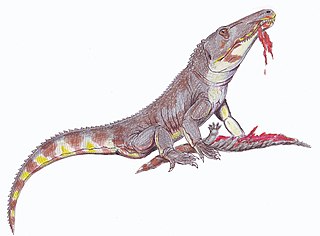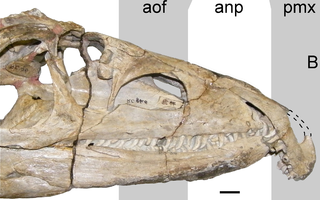
Chasmatosuchus was an archosauriform reptile from the early Triassic period of European Russia. One of the earliest described archosauriforms, it was over 2 m long and is thought to have behaved like a modern crocodile. Its mouth had two distinct features: the top of its jaw hooked downwards to aid in holding prey, and the upper palate was lined with a row of teeth—a primitive feature lost in later archosaurs.

Proterosuchidae is an early family of basal archosauriforms whose fossils are known from the Late Permian and the Early Triassic. The highest diversity of genera is known from European Russia, but fossils are also known from South Africa, India, China, Australia, Brazil and possibly Argentina. The name comes from Greek πρότερο- ("first") and σοῦχος ("crocodile").

Garjainia is an extinct genus of erythrosuchid archosauriform reptile from the Olenekian of Russia and South Africa. It was approximately 1.5–2 metres (4.9–6.6 ft) long. It contained two species, Garjainia prima from the Yarengian/Yarkenskian Supergorizont of Russia, and Garjainia madiba from the Burgersdorp Formation of South Africa. "Vjuskovia triplicostata", a name assigned to some erythrosuchid fossils from Russia, has been synonymized with Garjainia prima.

Proterosuchus is an extinct genus of archosauriform reptiles that lived during the Early Triassic. It contains three valid species: the type species P. fergusi and the referred species P. alexanderi and P. goweri. All three species lived in what is now South Africa. The genus was named in 1903 by the South African paleontologist Robert Broom. The genus Chasmatosaurus is a junior synonym of Proterosuchus.

Archosaurus is an extinct genus of carnivorous proterosuchid archosauriform reptile. Its fossils are dated to the latest Permian of Russia and Poland, it is one of the earliest known archosauriforms. The type and only species is Archosaurus rossicus, known from several fragmentary specimens which cumulatively represent parts of the skull and cervical vertebrae. It would have been 3 metres (9.8 ft) long when fully grown.
Dongusuchus is an extinct genus of archosaur. Fossils have been found from the Donguz Formation outcropping on the banks of the Donguz River in the Orenburg Oblast of Russia. They are associated with a fossil assemblage called the Eryosuchus Fauna, named after the capitosaurid Eryosuchus, the most common organism found from the assemblage. The locality dates back to the Anisian and early Ladinian stages of the Middle Triassic.
Jaikosuchus is an extinct genus of proterosuchid archosauriform. It contains a single species, J. magnus. Fossils have been found from European Russia that date back to the upper Olenekian stage of the Early Triassic.
Tsylmosuchus is an extinct genus of proterosuchid archosauriform reptile known from Western Russia. Fossils referred to Tsylmosuchus occurred over a wide area in sediments corresponding to the Induan and Olenekian stages of the Early Triassic. Most of these fossils are fragmentary neck vertebrae which were originally reported as sharing similarities with crocodile-line archosaurs (pseudosuchians) such as Mandasuchus. As a result, Tsylmosuchus was first described as part of the family Rauisuchidae, making it supposedly one of the oldest known archosaurs. However, its fragmentary remains do not show any of the distinguishing features of rauisuchids or even pseudosuchians in general, so Tsylmosuchus has more recently been interpreted as an indeterminate archosauriform. Although three species of Tsylmosuchus have been named, they lack diagnostic traits and are probably not distinct from each other. In 2023, Tsylmosuchus was reinterpreted as a proterosuchid, specifically a member of the subfamily Chasmatosuchinae.
Vjushkovisaurus is an extinct genus of Middle Triassic archosauriform. It is known from the Anisian-aged Donguz Gorizont in Sol-Iletsk, Orenburg Oblast, Russia. The genus was named in 1982, with the type species being V. berdjanensis. Material has been collected in the Berdyanka II locality from a fossil assemblage called the Eryosuchus Fauna along the Berdyanka River, specifically in a sand-carbonate concretion in the upper part of the main river channel. Vjushkovisaurus is known only from the holotype PIN 2865/62, a partial postcranial skeleton which consists of 12 presacral vertebrae, left humerus, ribs, a fragment of the coracoid and a fragment of the fibula.

Youngosuchus is an extinct genus of archosaur from the Middle Triassic of China. The type species is Y. sinensis. Y. sinensis was first described in 1973 as a new species of the erythrosuchid Vjushkovia. In 1985, it was reassigned as its own genus of rauisuchid. A 1992 study supported the original classification of Youngosuchus sinensis as an erythrosuchid, but more recent studies classify it as a "rauisuchian"-grade loricatan archosaur completely unrelated to Vjushkovia, which is most likely a synonym of Garjainia.
Blomosuchus is an extinct genus of archosauriform from the Early Triassic of Russia. The type species was named in 1992 as Blomia georgii. However, the name Blomia was preoccupied by a genus of mites in the family Glycyphagidae (Blomia), so the genus was renamed Blomosuchus in 1997. Fossils of Blomosuchus have been found along the Vetluga River besides fossils of another problematic archosauriform, Vonhuenia.
Dongusia is an extinct genus of rauisuchid reptile from the Middle Triassic of Russia. The type species D. colorata was named by German paleontologist Friedrich von Huene in 1940 on the basis of a single vertebra. This bone was found in the Sol-Iletsky District of Orenburg Oblast. Huene thought Dongusia was a primitive archosauriform. In the 1960s, D. colorata was included in the early archosauriform genus Erythrosuchus. In 1970, similarities were noted between the Dongusia vertebra and those of the rauisuchid "Mandasuchus" from Tanzania. The vertebra is now thought to belong to a rauisuchid, but the genus Dongusia is considered a nomen dubium because there are no diagnostic features in the single bone that distinguish it from other rauisuchids.
Exilisuchus is an extinct genus of archosauromorph reptile from the Early Triassic of Russia. The type species E. tubercularis was named in 1979. Fossils are known from two Russian assemblages, the Benthosuchus - Thoosuchus assemblage and the Angusaurus assemblage. Both are Olenekian in age. Although initially believed to be a proterosuchid archosauriform, a 2016 analysis found that it also shared features with tanystropheids, and thus is currently classified as Archosauromorpha incertae sedis. Due to the small amount of preserved material, this genus is sometimes considered a nomen dubium.
Gamosaurus is an extinct genus of proterosuchid archosauriform. It contains a single species, Gamosaurus lozovskii, named by Vitalii Georgievich Ochev in 1979.
Boreopricea is an extinct genus of archosauromorph reptile from the Early Triassic of arctic Russia. It is known from a fairly complete skeleton discovered in a borehole on Kolguyev Island, though damage to the specimen and loss of certain bones has complicated study of the genus. Boreopricea shared many similarities with various other archosauromorphs, making its classification controversial. Various studies have considered it a close relative of Prolacerta, tanystropheids, both, or neither. Boreopricea is unique among early archosauromorphs due to possessing contact between the jugal and squamosal bones at the rear half of the skull.
The Yarenskian Gorizont is a major biostratigraphic unit in Russia corresponding to Upper Olenekian-age terrestrial sediments. It lies above the Ustmylian Gorizont of the Vetlugian Supergorizont, and is located below a short unconformity overlain by the Donguz Gorizont. Some paleontologists elevate the Yarenskian to a supergorizont and subdivide it into two smaller units: the older Fedorovskian Gorizont and the younger Gamskian Gorizont. Others prefer to consider the Fedorovskian and Gamskian to be subgorizonts or members of the Yarenskian. Vertebrate index fossils of the Fedorovskian include the lungfish Gnathorhiza, the trematosaurid Inflectosaurus, and the procolophonid Burtensia. In the Gamskian, these index fossils are replaced by Ceratodus, Trematosaurus, and Kapes, respectively. The Yarenskian as a whole is characterized by the capitosaur amphibian Parotosuchus, and has also been known as the Parotosuchus fauna. A few geographical influence on the faunas can be observed; erythrosuchids and rhytidosteids are more common in southern exposures while procolophonids and putative "rauisuchids" are more common in the north.
The Ustmylian Gorizont is a Lower Triassic biostratigraphic unit in Western Russia. The Ustmylian Gorizont is the youngest subunit of the Vetlugian Supergorizont, lying above the Sludkian Gorizont and below the Yarenskian Gorizont. It corresponds to the later part of the early Olenekian stage. Along with the Sludkian Gorizont, the Ustmylian Gorizont is encompassed by the "Wetlugasaurus fauna", named after a capitosaur amphibian index fossil. While the Sludkian is characterized by Wetlugasaurus angustifrons, the Ustmylian is characterized by Wetlugasaurus malachovi.
The Sludkian Gorizont is a Lower Triassic biostratigraphic unit in Western Russia. The Sludkian Gorizont is a part of the Vetlugian Supergorizont and corresponds to the middle part of the early Olenekian stage, lying above the Rybinskian Gorizont and below the Ustmylian Gorizont. The Sludkian and Ustmylian Gorizonts are together encompassed by the "Wetlugasaurus fauna", named after a capitosaur amphibian index fossil. The Sludkian is characterized by Wetlugasaurus angustifrons, while the Ustmylian is characterized by Wetlugasaurus malachovi.
The Rybinskian Gorizont is a Lower Triassic biostratigraphic unit in Western Russia. It is a part of the Vetlugian Supergorizont and corresponds to the earliest part of the Olenekian stage, lying above the late Induan-age Zaplavnian Horizon and below the Sludkian Gorizont. The Rybinskian Gorizont is sometimes known as the Benthosuchus fauna, due to abundant fossils of Benthosuchus, a temnospondyl amphibian index fossil. Related amphibians such as Thoosuchus also increase in abundance, and the interval additionally hosts the oldest fossils of procolophonines and putative true archosaurs in the region.
Samsarasuchus is an extinct genus of archosauriform reptile from the Early Triassic of India. This genus has one known species, Samsarasuchus pamelae. Samsarasuchus lived a few million years after the Permian-Triassic extinction, the largest known mass extinction event. It was a member of the Proterosuchidae, a group of successful crocodile-like reptiles that survived the extinction event and were among the earliest successful archosauromorphs.







